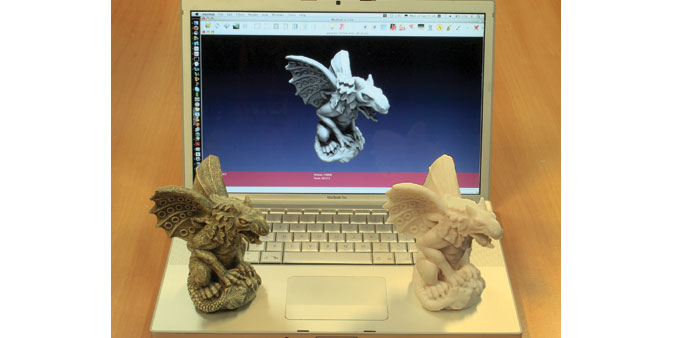* A model (left) that was digitally acquired by using a 3-D scanner, the scanned data processed using MeshLab, and the resulting 3-D model used by a rapid prototyping machine to create the resin replica (right). Photographs: Wikipedia

By Omar L Gallaga
If you are old enough to have experienced it, you probably had that moment in the ’90s or early 2000s when you realised everything was about to change.
The sweeping Internet was changing music, reading, how we processed information, even the words we used to communicate. The change was fundamental and it happened so quickly, many of us had to catch our breath and keep ourselves from getting dizzy when we realised its significance.
It may sound like hype, and I’ll try to avoid overstating it, but a lot of us who write about where technology is going are starting to feel the same kind of change in the air. It’s because of another emerging technology that will likely rush in and modify our daily lives before we even know it’s happening: 3-D printing.
At this year’s South by Southwest Interactive, 3-D printing was the subject of panels, workshops and a well-received opening remarks session from Bre Pettis, a former teacher who now runs a 3-D printer company called MakerBot.
Pettis did a nice job explaining the significance and practical applications of 3-D printing without sounding like a salesman.
In addition to toys, trinkets and plastic do-dads like replacement parts for home appliances, a 3-D printer can mass-produce medical tools and even prosthetic limbs for children. It can also make cheap parts to build firearms.
Unlike some technologies touted at the festival, this one felt less like a possible future and more like an inevitability. It no longer feels like a matter of whether 3-D printers will come along and change our lives; it now seems like only a question of how soon.
Richard Goodwin, a technical product manager at Rackspace in Austin, is one of those guys who’s taking the hits on the speed bumps of new technology before early adopters even get there.
He bought a printer called a Mosaic 1 from a company called MakerGear, and when he started printing small objects like Yoda heads and bracelets, he says he found “worlds of fun, small countries of frustration.”
3-D printers are still so new that they can be finicky. The way many of them work is this: In a space the shape of a box, a nozzle heats up material (typically plastic, liquid or powder depending on the device) and “prints” a flat layer on a surface, using information from a virtual 3-D model.
The nozzle goes up a tiny bit (about 0.1mm in most cases) and prints another layer on top of that, molding the material together. It does that again and again, moving around in the space of the box until it has made an object. 3-D printers can cost tens of thousands of dollars, but some of the more consumer-friendly ones can be had for about $2,000 or less and are quickly getting cheaper.
Goodwin says that 3-D printer hobbyists have to learn how to calibrate a printer, what to do when a printing fails and how to wait, sometimes for hours, for the process to finish. “The technology is nowhere near, say, an inkjet printer yet,” Goodwin said.
He compares having a 3-D printer now to being one of the first TV owners. It might have worked fine part of the time, but sometimes you’d “spend a half hour tinkering with the dials, the antenna and smacking it on the side just to get that snowy mess to turn into a perfect picture everyone could enjoy,” he said.
There’s a large online community of “Makers” who share designs for objects that can be downloaded from sites like Thingiverse.com and printed. But who owns a 3-D design if it’s modelled after, say, a Disney character?
We’re due for a major showdown on the copyright implications of 3-D printing. But it also opens up the idea of a future where many of us just download and print out goods instead of buying them online and having them shipped.
Feel that sea change?
Clay Shortall, the founder of Austin’s Shortall Architectural Design, echoed some of the tinkering troubles that Goodwin expressed. He has a 3-D printer called a Replicator 2 from MakerBot that he’s played around with at home. “They’re really cool and fun to play with,” Shortall said, the kind of technology you want to show off to guests when they come over, he said.
“It’s a fun party trick,” Shortall said. “It’s the new thing.”
But Shortall has gotten more use from the Replicator 2 by testing out models for much larger projects that will eventually be printed on large, industrial machines out of materials like limestone or granite. For $25 or so, he can print a smaller version of, say a home or a skate park he’s helping design.
Shortall, who also teaches at the University of Texas, has found it a useful educational tool. It’s one thing to model something virtually on a computer; it’s another to test out the structural soundness of a physical model you can hold in your hands.
He says it can save students time to have a 3-D printed object created in a few hours rather than building the same object by hand.
“We haven’t figured out all the nuances of it yet,” Shortall said. He imagines that before the tech can go mainstream, many more people will have to find ways to make 3-D printing useful and incorporate it into their lives in time-saving ways.
How long will that be? If I had to guess, I’d say that within two or three years, as the hardware and software improves, more early adopters will want to experiment with printers and 3-D scanners.
Perhaps in five years, we’ll see idiot-proof 3-D printers for just a few hundred dollars, ready for your home.
3-D printing may look different and come in a different kind of box by then, but it’s a safe bet that one way or another, it’s in our future. —Austin American-Statesman/MCT
Why are people buying ‘Bitcoins’?
A new kind of online currency that favours anonymity and is (so far) very secure has been in the news recently as its value has shot up dramatically. But most people still don’t know what a Bitcoin is and where it comes from.
Bitcoin’s origins are murky, but it began as a project in 2009 under the pseudonym “Satoshi Nakamoto”. Sophisticated programming creates new Bitcoins at a set rate of time. Those who trade Bitcoins install so-called wallet software on their computers that allows them to buy or sell Bitcoins online. While some exchanges for Bitcoins have been hacked, the currency itself has so far held secure; no one has yet been able to copy a Bitcoin.
The wallet software keeps identities of buyers and sellers anonymous, which has caused Bitcoins to be linked to illicit markets.
Only 21mn Bitcoins are planned to be created and perhaps because of that limit and the slowing rate of new Bitcoin creation, their value continues to climb. As of this writing, a Bitcoin is worth more than $200, but the pricing fluctuates wildly.
The rush to buy Bitcoins as the value has soared has fuelled concerns that there may be a bubble in the Bitcoin market. A crash of the currency last week (which then rebounded) doesn’t seem to have alleviated those fears.

